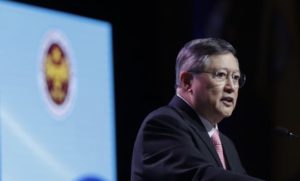MANILA, Philippines — Prices of basic goods and services rose slightly last month – to a level that was within the central bank’s expectations – but any further increases will almost certainly be capped by the lingering weak demand caused by the ongoing coronavirus pandemic.
In a statement to the press, Bangko Sentral ng Pilipinas (BSP) Governor Benjamin Diokno described the June consumer price index of 2.5 percent, up from 2.1 percent in May, as “consistent with the [agency’s] prevailing assessment that inflation pressures remain limited.”
The central bank had predicted last week that last month’s inflation rate would fall within the range of 1.9–2.7 percent.
“The latest baseline forecasts suggest a benign inflation environment over the policy horizon,” Diokno said, adding that the pace of price increases is expected to average at 2.3 percent for 2020, 2.6 percent for 2021, and 3.0 percent for 2022.
The central bank expects domestic economic activity to follow a U- shaped quarterly recovery path with output likely to contract further in the remaining quarters of 2020. Growth is expected to recover in 2021 once the impact of government policy support measures gains traction.
Meanwhile, Diokno said the outlook for the global economy has further deteriorated with considerable uncertainty brought about by the magnitude and duration of containment measures across all economies.
“The BSP remains committed to the use of monetary instruments and regulatory relief measures when needed further in fulfillment of its mandate to promote non-inflationary and sustainable growth,” the central bank chief said.
Separately, ING Bank Manila senior economist Nicholas Mapa noted that price pressures remain weak as demand remains crippled by record-high unemployment.
“Despite the acceleration in June, price pressures remain subdued with the economy reeling from the ill effects of the three-month lockdown imposed last March,” he said in a note to the press. “With unemployment skyrocketing to 17.7 percent in the second quarter, demand for commodities remains weak.”
The main drivers for the slight uptick from the May inflation number were the slight gain in food prices and the normalization in transport costs with crude oil prices recovering. Offsetting the upward pressure on headline inflation was the price for utilities with power companies offering refunds in light of the pandemic.
Mapa said that inflation is set to settle at the lower end of the BSP’s target band and allow the central bank to keep an accommodative stance.
“However, with the BSP’s real policy rate now negative (-0.25 percent), we reiterate our expectation that the central bank will refrain from cutting policy rates further and look to additional liquidity enhancement measures should the economy needs more stimulus,” he said.
He said the peso will likely continue enjoying short-term strength as the surprise inflation reading will likely mean BSP policy rate cuts are off the table for the time being.


